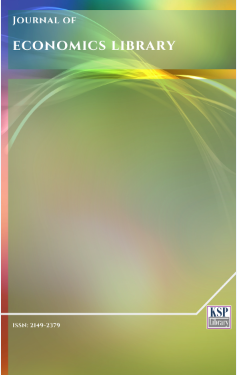Mathematical Analysis of the Historical Economic Growth with a Search for Takeoffs from Stagnation to Growth
Abstract
Abstract. Data describing historical economic growth are analysed. Included in the analysis is the world and regional economic growth. The analysis demonstrates that historical economic growth had a natural tendency to follow hyperbolic distributions. Parameters describing hyperbolic distributions have been determined. A search for takeoffs from stagnation to growth produced negative results. This analysis throws a new light on the interpretation of the mechanism of the historical economic growth and suggests new lines of research.
Keywords. Historical economic growth; regimes of growth; stagnation; take offs; Malthusian trap; hyperbolic growth.
JEL. A10, B15, B16, B22, C29.
References
BBC, (2014).The North South Divide. http://www.bbc.co.uk/bitesize/standard/geography/international_issues/contrasts_development/revision/2/
Duignan, P., & Gunn, L. H. (Eds.) (1973).Colonialism in Africa 1870 – 1960: A Bibliographic Guide to Colonialism in Sub-Saharan Africa. Cambridge, UK: Cambridge University Press.
Floud, D. & McCloskey, D.N. (1994). The Economic History of Britain since 1700. Cambridge: Cambridge University Press.
Galor, O. (2005). From stagnation to growth: Unified Growth Theory. In P. Aghion& S. Durlauf (Eds.), Handbook of Economic Growth, (pp. 171-293). Amsterdam: Elsevier.
Galor, O. (2008). Comparative Economic Development: Insight from Unified Growth Theory. http://www.econ.brown.edu/faculty/Oded_Galor/pdf/Klien%20lecture.pdf
Galor, O. (2011). Unified Growth Theory.Princeton, New Jersey: Princeton University Press.
Galor, O. (2012). Unified Growth Theory and Comparative Economic Development. http://www.biu.ac.il/soc/ec/students/mini_courses/6_12/data/UGT-Luxembourg.pdf
Maddison, A. (2001). The World Economy: A Millennial Perspective. Paris: OECD.
Maddison, A. (2010). Historical Statistics of the World Economy: 1-2008 AD. http://www.ggdc.net/maddison/Historical Statistics/horizontal-file_02-2010.xls.
McKay, J.P., Hill, B. D., Buckler, J., Ebrey, P. B., Beck, R. B., Crowston, C. H., &Wiesner-Hanks, M. E. (2012). A History of World Societies: From 1775 to Present. Volume C – From 1775 to the Present. Ninth edition. Boston, MA: Bedford Books.
Nielsen, R. W. (2014). Changing the Paradigm. Applied Mathematics, 5, 1950-1963. doi. 10.4236/am.2014.513188
Nielsen, R. W. (2015a). The Insecure Future of the World Economic Growth. Journal of Economic and Social Thought, 2(4), 242-255.
Nielsen, R. W. (2015b). Unified Growth Theory Contradicted by the GDP/cap Data.http://arxiv.org/ftp/arxiv/papers/1511/1511.09323.pdf
Nielsen, R. W. (2016). Hyperbolic growth of the world population in the past 12,000 years and its link to the economic growth. Turkish Economic Review, 3(1), forthcoming
Pakenham, T. (1992). The Scramble for Africa: White Man’s Conquest of the Dark Continent from 1876-1912. New York: Avon Books.
Pereira, E. (2011). Developing Countries Will Lead Global Growth in 2011, Says World Bank. http://www.forbes.com/sites/evapereira/2011/01/12/developing-countries-will-lead-global-growth-in-2011-says-world-bank/
Teeple, J. B. (2002). Timelines of World History, London, Dorling Kindersley Publishing Inc.
von Foerster, H., Mora, P., & Amiot, L. (1960). Doomsday: Friday, 13 November, A.D. 2026. Science, 132,1291-1295.
DOI: http://dx.doi.org/10.1453/jel.v3i1.606
Refbacks
- There are currently no refbacks.
.......................................................................................................................................................................................................................................................................................................................................
Journal of Economics Library - J. Econ. Lib. - JEL - www.kspjournals.org
ISSN: 2149-2379
Editor: [email protected] Secretarial: [email protected] Istanbul - Turkey.
Copyright © KSP Library

